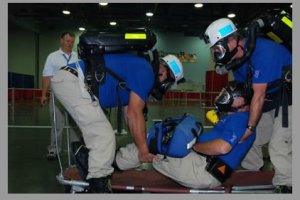 "Can you hear me now?" The answer was a resounding "Yes" as mine rescue personnel deep underground were able to communicate with the surface command center as new technology was put to the test April 8 during a mine rescue simulation in West Finley, Pennsylvania at the Harvey Mine, owned by Consol Energy Inc.
"Can you hear me now?" The answer was a resounding "Yes" as mine rescue personnel deep underground were able to communicate with the surface command center as new technology was put to the test April 8 during a mine rescue simulation in West Finley, Pennsylvania at the Harvey Mine, owned by Consol Energy Inc.
Fortunately, the emergency was a simulated disaster — part of a mock mine emergency exercise — sponsored by the Mine Safety and Health Administration (MSHA), which used the event to showcase a new wireless system that has been years in development.
Smoke-filled tunnels
MSHA's mine emergency unit joined forces with CONSOL's eight rescue teams, the Pennsylvania Department of Deep Mine Safety and the Pennsylvania Special Medical Response Team in a series of drills that featured injured miners and smoke-filled tunnels.
The new technology allows for direct communication between the advancing mine rescue teams and the command center, while back-up rescue teams standing-by at a fresh air base are kept in the loop with real time information. Previously, messages were passed from person to person and team to team, creating an inherent risk of miscommunication.
No more Pony Express
"This is a real game changer in mine rescue," said MSHA chief Joseph A. Main, who said the system will make mine rescue quicker and safer. "The old method of relaying the results of exploration through multiple persons — almost like a 'Pony Express' system that often led to miscommunication — is over."
In a recent post on the U.S. Department of Labor Blog, Main said a series of recent mine emergency events — including the Sago, Aracoma and Darby coal mine fires and explosions in 2006, the ground failure at the Crandall Canyon coal mine in 2007, and the Upper Big Branch coal mine explosion in 2010 — exposed shortcomings in mine emergency response and mine rescue readiness.
Fixing the problems
“To address those shortcomings and ensure that mine rescuers are as prepared as possible for some of the most dangerous emergency response work undertaken, I launched an initiative in 2010 to identify and fix gaps in mine emergency and rescue response and readiness.”
In addition to the advances in communication, Main described other forms of mine rescue technology that have been developed over the past five years:
- New mapping technology allows the command center and other rescuers to watch the progress of the advancing rescue team in real time.
- New atmospheric monitoring technology features sensors that can be left at locations in the mine as rescuers move forward, or are forced to retreat. The monitors continue sending air quality information to the command center and providing reentering teams with better information on mine gases that are too often unknown.
- Upgraded MSHA command centers are designed to manage the new information streams and quickly relay critical information to others coordinating the mine emergency.


